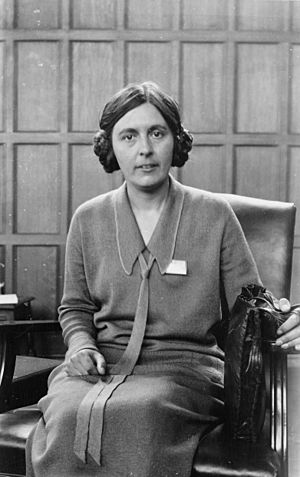Kathleen Bever Blackburn facts for kids
Quick facts for kids
Kathleen Bever Blackburn
|
|
|---|---|

Blackburn, probably in 1926 when attending the International Botanical Congress at Ithaca, New York
|
|
| Born | 1892 |
| Died | August 1968 (aged 75–76) |
| Citizenship | British |
| Scientific career | |
| Fields | Botany |
| Institutions | Armstrong College |
Kathleen Bever Blackburn (1892–1968) was a British botanist. She is famous for discovering in 1923 that plant cells have sex chromosomes. She made important discoveries in plant cytology (the study of cells) and genetics (the study of how traits are passed down). She was also a pioneer in palynology, which is the study of pollen.
Blackburn taught botany (the study of plants) at Armstrong College in Newcastle from 1918 to 1957. This college later became part of Newcastle University.
Contents
Early Life and Education
Kathleen Bever Blackburn was born in 1892. Her father, E. P. Blackburn, was a well-known minister in the Methodist Church. He was also a keen naturalist who studied shells. Kathleen and her sister Dorothy were active members of their church.
Kathleen studied at Bedford College, London, which is part of the University of London. She earned her Bachelor of Science (BSc) degree in 1912. She then completed her Master of Science (MSc) degree in 1914.
Career and Discoveries
From 1914 to 1916, Blackburn worked as a botany lecturer at Southlands Training College in London. In 1918, she became a lecturer in botany at Armstrong College in Newcastle. She became a Reader in Cytology in 1947. This meant she was a senior academic who led research. She retired in 1957.
Research on Plant Chromosomes
At Newcastle, Kathleen Blackburn did a lot of research. She often worked with J.W. Heslop-Harrison, who was the head of her department. Her first published work in 1917 looked at the tiny tubes inside buttercup seedlings.
In the early 1920s, she studied the chromosomes of British roses. Chromosomes are structures inside cells that carry genetic information. She found that roses have a basic number of seven chromosomes. She also showed that different types of roses were polyploid. This means they had more than two sets of chromosomes. Her work helped scientists understand how different rose types are related.
Discovery of Sex Chromosomes in Plants
Blackburn then studied campions, which are a type of flowering plant. In 1923 and 1924, she discovered that male and female campion flowers have X and Y sex chromosomes. She was the first person to correctly identify the Y chromosome as being larger than the X chromosome in Silene latifolia, a type of campion.
Before her discoveries, scientists did not know that plants had sex chromosomes. It is now known that X and Y sex chromosomes are rare in plants. They are only found in a few types of plants where male and female flowers grow on separate plants.
Pollen Analysis and Ancient Environments
By the 1930s, Blackburn became very skilled at studying pollen. She looked at pollen grains found in peat, which is partly decayed plant matter. This helped her investigate how landscapes were repopulated after the ice ages.
In the 1940s, she researched soils and peat bogs. This work helped with the development of the Kielder Forest. She was also able to reconstruct what ancient plant life looked like. She did this by studying pollen and plant pieces found by archaeologists. This helped with digs at Hadrian's Wall and other places in North East England.
Other Interests
Kathleen Blackburn was also an active field botanist. This means she enjoyed studying plants in their natural environment. She was a member of several natural history groups. She went on trips to the Hebrides islands in the 1930s to study plants there. She also helped manage the Hancock Museum.
Personal Life
Kathleen Blackburn was quite independent for her time. She rode a motorcycle when they were new. Later, she drove her own car, which was unusual for women then. She never married and lived with her sister Dorothy in Jesmond, Newcastle upon Tyne.
She enjoyed acting and was part of the Armstrong College Staff Dramatic Society. She also gave talks about plants to groups outside the university. She wrote articles about botany for the general public.
Retirement and Death
Kathleen Blackburn retired in 1957. She passed away in August 1968 from Parkinson's disease.
Awards and Recognition
By 1927, Blackburn was elected a Fellow of the Linnean Society of London (FLS). This is a high honor for naturalists. In 1930, she received the Trail Award and a gold medal from the Linnean Society. This award was given for her amazing work in biological microscopy, which is using microscopes to study living things.
Images for kids
-
Blackburn, probably in 1926 when attending the International Botanical Congress at Ithaca, New York


